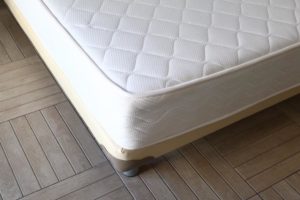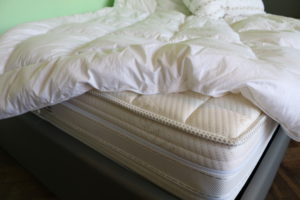How to Fix a Sagging Mattress: Tips & Solutions
Is your mattress not as comfortable as it once was? Have you noticed some sagging in the areas that you sleep on most? This article will discuss how to fix a sagging mattress, and when it’s time to buy a new bed.
Sagging is one of the most common complaints from mattress owners. All mattresses will sag eventually, and this effect will have a significant impact on the bed’s feel and comfort. Thankfully, there are a few things that mattress owners can do to help minimize the effects of sagging.
Let us help you find the perfect bed
Answer a few questions to find the right mattress for your unique needs
How to Fix a Sagging Mattress
Unfortunately, you can’t really “fix” a sagging mattress. The only true fix is to send it in to the manufacturer for repairs, or to replace it completely.
With that said, there are several things that mattress owners can do to minimize the effects of sagging. These strategies vary in effectiveness, depending on the age of the mattress and the severity of the sagging. Here are a few strategies that you can try:
1. Use a Mattress Topper
Purchasing a mattress topper can help you sleep more comfortably on a mattress that is sagging. As the name suggests, mattress toppers are simply placed on top of your bed, offering an additional layer of comfort on top of the existing mattress.
Mattress toppers are sold individually as accessories, and usually feature 2 to 5 inches of foam, latex, wool, down, down alternative, or feathers. In the case of countering mattress sagging, the thicker toppers made from denser materials tend to perform best.
A good mattress topper can help reduce the effects of a sagging mattress by providing a more even sleep surface. Toppers are a popular option for folks who are not yet ready to purchase a new mattress, but want to improve the comfort of their existing bed. In other words, a mattress topper won’t fix a sagging mattress, but it’s an affordable temporary measure to improve your comfort.
2. Rotate the Mattress
Unless the manufacturer specifically recommends against it, most mattresses should be rotated regularly. By rotating a mattress, swapping the foot and head of the bed, you can extend its lifespan significantly. Regularly rotating a bed will help to prevent premature sagging. Doing so every three to six months is a good rule of thumb.
If your mattress is already sagging, rotating it can still help. Excessive sagging tends to occur in the areas of the mattress that are put under the most pressure by the sleeper’s body. This tends to be the areas around the hips and shoulders. Rotating your mattress allows the heavier parts of your body to rest on areas of the mattress that are not yet sagging.
Note: Most mattresses should not be flipped, unless it is specifically recommended by the manufacturer. Most modern mattresses are designed to be one-sided, so flipping them will generally result in poor comfort and an increased chance of damage to the bed.
3. Replace the Foundation
In many cases, the foundation of your bed can contribute to premature mattress sagging. Foundations with fewer than six legs can often cause premature sagging, as there is less support around the center of the mattress. Similarly, foundations that utilize slats can also cause sagging issues, particularly in the areas that fall in between the support of the slats. Older foundations can also wear out over time.
The type of foundation that’s best suited to your mattress depends on several factors. It’s best to check with the manufacturer of your mattress for guidance on the foundation style you should be using. Many manufacturers specify the minimum allowable distance between the support slats, which also often impacts your mattress’ warranty.
4. Use Extra Pillows
As a temporary measure to counter sagging, some people use extra pillows placed in the areas where the mattress is sagging. Some like to sleep with a pillow underneath their hips, back, or legs. For this purpose, pillows with good shape retention are best.
Some guides suggest putting pillows underneath the mattress itself, to help prop up areas that are sagging. We do not recommend this strategy, as it can accelerate the aging of the mattress by preventing even support.
5. Explore Warranty Coverage
If your mattress is sagging, it’s definitely worth checking the terms of your manufacturer’s warranty. If the damage is caused by a covered reason, you may be able to get your bed repaired, or even replaced, by the manufacturer.
What Causes a Mattress to Sag?
Sagging is typically the result of normal wear-and-tear to your mattress. The foam materials used in mattresses tend to soften over time, as they are exposed to significant pressure every night from the sleeper’s body. Over time, this gradual softening of foam leads to a feeling of sagging, and less even support.
In innerspring and hybrid mattresses, sagging is also common. The metal coils used in these beds tend to lose tension over time while the comfort layers soften, leading to less rigid support in problem areas.
Sagging usually occurs in the areas that are exposed to the most pressure. Typically, this includes areas that support the hips and shoulders.
A sagging mattress will provide uneven support, which can significantly reduce comfort and sleep quality.
When to Replace Your Mattress
If your mattress is sagging, it may need to be replaced. The strategies described in this article are meant to provide temporary improvements for a sagging mattress, but they won’t fix the root problem.
Generally, mattresses should be replaced every 6 to 10 years. If your mattress begins to sag excessively, it should be replaced as soon as possible.

Still have questions? Ask our community!
Join our Sleep Care Community — a trusted hub of sleep health professionals, product specialists, and people just like you. Whether you need expert sleep advice for your insomnia or you’re searching for the perfect mattress, we’ve got you covered. Get personalized guidance from the experts who know sleep best.




















































